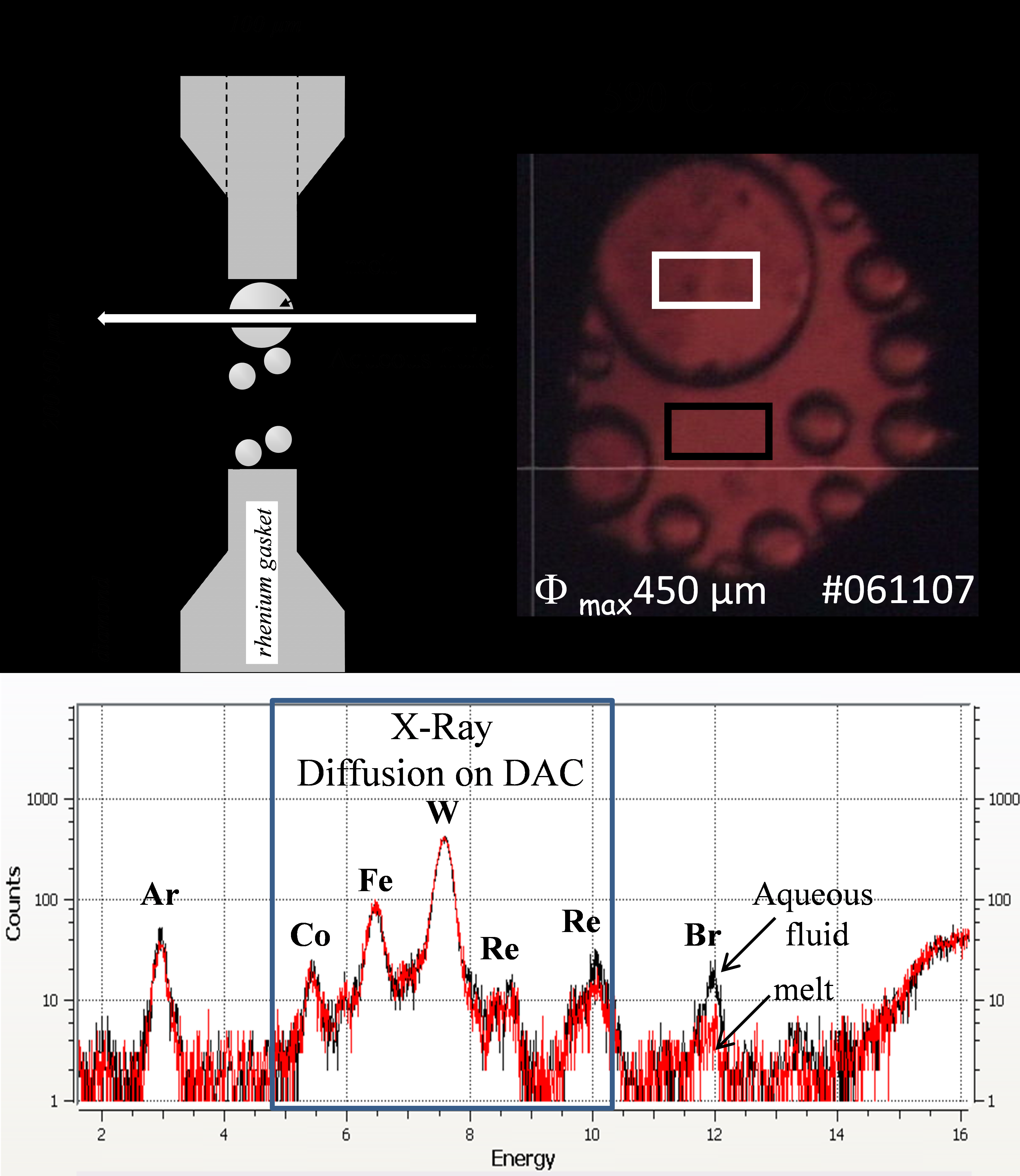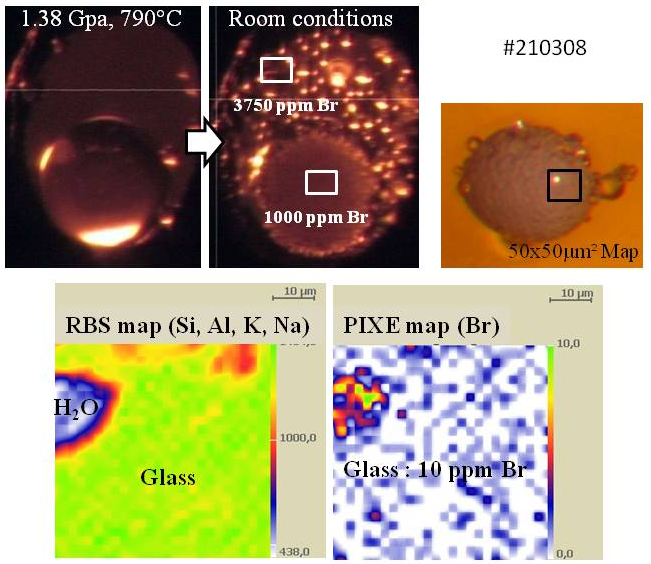

|
Bromine is a poorly known element in Earth Sciences, more especially in the deep crust and mantle. Whereas this element is not concentrated in natural rocks, Br is an efficient ozone killer and has been found to be released to the atmosphere through volcanism. In order to constrain the Br geodynamical cycle of the Earth, we have experimentally monitored Br degassing and Br recycling through the subduction factory. |
A window into the Earth : DAC combined with in situ SXRF
Experiments were performed in Bassett-modified Diamond Anvil Cells (DAC) from room pressure to 1.7 GPa and up to 890°C. Pieces of a Br-enriched synthetic glasses, used as analogue for natural melts, were loaded in the DAC together with water. Experiments were started at room conditions with heating stages inducing pressure increases. They were combined with in situ X-Ray fluorescence measurements at the Synchrotron SOLEIL DIFFABS beamline. The incident focused X-Ray beam crossed the DAC sample chamber through the diamonds, the XRF radiation was detected by a Si-drift detector. The temperature was increased to achieve total miscibility between aqueous fluid and silicate melt (Bureau and Keppler, 1999), afterward T was decreased to induce decompression. Below the critical domain, hydrous melt and aqueous fluid are coexisting. The X-Ray µ-beam was then adjusted to cross the aqueous fluid, or the hydrous melt (figure 1), allowing quantification of the amount of Br dissolved in both phases at equilibrium, for each decompression step. This was used to simulate the magma ascent and degassing process. At the end of the experiment, the assemblage was quenched to room conditions inducing water bubbles nucleation in the melts.
Systematic post mortem characterization on quench glasses : PIXE and RBS
After the quench, glasses and aqueous fluids, were analyzed in situ. The glasses were also analyzed ex situ using Ion Beam Analysis at the SIS2M LEEL Nuclear Microprobe, CEA Saclay. This was useful to determine the amount of Br in the degassed materials (i.e. glass and water bubbles). Indeed, Br behavior was experimentally monitored in situ from conditions relevant to deep magma conduits to those of the atmosphere.
Figure 2 : picture of the assemblage in situ at 1.38 GPa and 790°C and at room conditions after quench. Water bubbles have nucleated and grown into the silicate phase due to degassing and have been preserved as a glass at room conditions. In situ XRF analyses were performed in the aqueous fluid and in the glass globule (white rectangles, 30x50 µm²), they show Br contents of 3750 ppm in the fluid and 1000 ppm in the water contaminated glass. The quench glass was picked up from the sample chamber and characterized by ex situ simultaneous PIXE and RBS mapping (50x50 µm², beam 4x4 µm²). The RBS map (Al, Si, Na, K) shows the presence of water bubbles, the PIXE map of Br shows that Br is concentrated in the water bubble. The residual glass is containing 10 ppm Br.
Bromine partitioning
Partition coefficients were calculated for each phase equilibrium at P and T, following the equation: DBrfluid/melt = (Br)fluid/(Br)melt, DBrfluid/melt was systematically > 1 which confirms the increasing affinity of Br for the aqueous phase, leaving the silicate phase during decompression.
Shallow recycling of bromine in subduction
Because of its strong affinity to water or water-rich melts compared to minerals, Br would remain in the “fluid” phases at depths > 60 km, during the fertilization of the mantle. Subduction zone primary magmas should be Br enriched compared to other settings.
Bromine degassing during subduction-related volcanism
Br flux to the atmosphere can be deduced by using calculation from initial volatile contents of melts assuming that all of the Br present in the melt is degassing. We can estimate a global arc Br annual yield flux from 9.7 to 17 kt/yr. This is equivalent to bromine emission directly measured at Mount Etna alone.
Attempt to characterize the deeper bromine cycle in subduction zones
The deeper behavior of Br in the transition zone, in the lower mantle or in the core, remains totally unknown today, but will be possible to investigate in the future through micro-experimental petrology investigations.
Références :
- Bureau et al., Earth and Planetary sciences Letters, 183 (2000) 51.
- Bureau and Keppler, Earth and Planetary sciences Letters, 165 (1999) 187
•  Physics and chemistry for life sciences and the environment
Physics and chemistry for life sciences and the environment
• UMR 3299 - Service Interdisciplinaire sur les Systèmes Moléculaires et les Matériaux • Service Interdisciplinaire sur les Systèmes Moléculaires et les Matériaux
• Laboratoire d'Etude des Eléments Légers (LEEL) • Laboratory for light element studies







